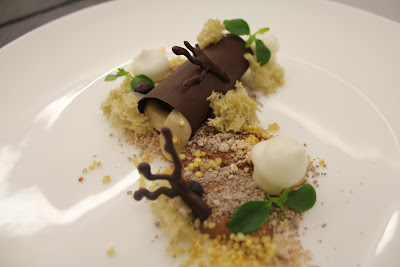What are food hydrocolloids and what can we do with it in the kitchen?
Hydrocolloids or gums are waters dispersable products producing gels or viscous liquids.
There exist 2 different types of hydrocolloids: thickeners and gelling agents
Hydrocolloids disperse or “dissolve” in water. A hydrocolloid in solution can be compared with a strand where molecules of water are bound to.
In a thickened product, these strands with bound water are moving separately and freely, which results in a product with fluid properties. In a gelled product, the strands are bound to eachother and form three dimensional network, in which the water molecules are kept. This product does not have fluid properties and is more like a solid.
In addition to their primary purpose of thickening and/or gelling, they often have secondary functions, such as emulsifier, whipping agent,… .
Gelatine for example produces a gel when cooled down. We can also use gelatine as an emulsifier (a gelatine based gel mixed with some oil gives a mayonnaise-like structure), a whipping agent (a whipped mixture with gelatine gives a marshmallow-like structure) or clarification agent (a stock lightly gelled with gelatine, frozen and defrosted gives a consommé).
In following examples the students made some dishes using different hydrocolloids.
Deconstruction of a crab cocktail: tomato paper, marshmallow of tomato, flexible gel of ketchup filled with crab mayonnaise, grapefruit fluid gel
Cod – aubergine/miso gnocchi – pork dashi – lemon zest
Deconstruction of a classic Foret Noir: chocolate flan, cherry crème, cherry crumble, cherry croquant, pâte de fruit of cream and Kirsh
Forest: chocolate/hazelnut espuma, chocolate powder, hazelnut powder, lemon merinque, pistachio/hazelnut sponge cake, cep ice cream, puffed quinoa
Deconstruction of a classic “Hutespot”: Brussels sprout sponge cake, pickled carrots, mustard sphere, leek mayonnaise, potato espuma, turnip, puffed pork fat, onion foam









Geen opmerkingen:
Een reactie posten